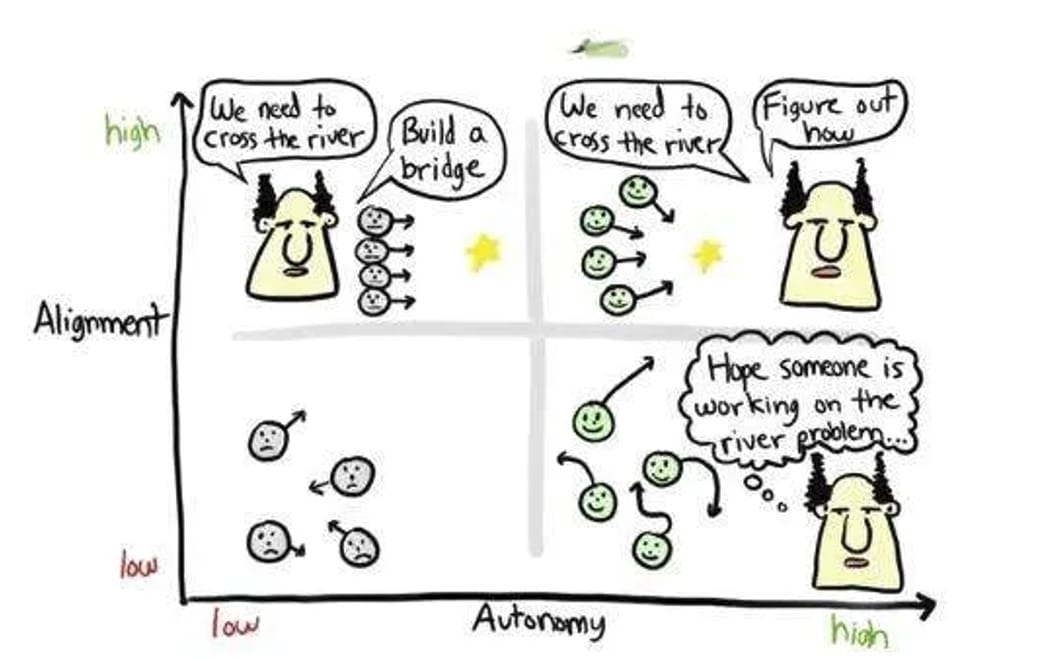Agile practitioners often refer to the four quadrants that make up the culture of autonomy and alignment. As one of the most reused concepts of the past decade, it demonstrates how teams need autonomy to be efficient, but must be aligned with the organization’s goals and roadmap. Depicted in figure 1, from Spotify, the general idea is that you would want to be in the top right-hand corner in an Agile environment.

part 1, Henrik Kniberg, 2019.
Generally, people think it is a good idea to create an environment with high alignment and high autonomy. Balancing these factors is critical to good performance in Agile organizations. But try asking how you can create a situation like this and what people need to do to get there and you’ll be met with silence. To help, we’ve created a model for Agile performance management that highlights everything needed for the creation of ahigh-alignment, high-autonomy environment.
Difficulties in Creating Autonomy and Alignment
Creating a performance culture of high alignment and high autonomy is not a one-time effort. It needs continuous attention and must be built across the entire organization. Nor is it as top-down as the Spotify illustration suggests—where leadership sets the goal and others figure out how to achieve it. For this culture to work, everyone needs to have a high degree of motivation and engagement—thinking strategically for the company and expressing professional opinions. Employees should thoughtfully consider and suggest goals that resonate with their needs, and leaders should provide feedback in ‘the how’ of achieving them. So, it’s not a one-off or top-down solution, and certainly not easy. It takes open communication and engagement between all parties.
If that isn’t enough, a lot of Agilists cringe at the idea of performance in an Agile environment. It’s almost as if it was a dirty word, because, as they say, “Wasn’t this the dominant, KPI-driven, directive, performance-drivenmindset we tried to get rid of in the first place? Agile isn’t about performance!”
When you look at the foundations of the Agile mindset, we see that one of its core values states: working product over processes and tools. So, if push comes to shove, the outcome is more valuable than how we got there. In addition, there are many Agile principles that are performance-based.
The model we have created is meant to provide a guideline for people working towards this sort of organizational culture, and to offer an overview and insight into this complex subject.
Defining Agile Performance Management
The model we use for Agile performance management is based on the following definition: Agile performance management enables quick alignment, execution and re-configuration of strategy, from leadership to individual team members and vice versa. Simple structures and feedback loops allow fast information flow, short decision cycles and increased adaptability for the co-creation of value by balancing the following:
- Autonomy ‹-› Alignment
- Learning ‹-› Performing
- People culture ‹-› Performance culture
- Flexibility ‹-› Stability
- Organizational development ‹-› Value creation
As you can see from our definition, Agile performancemanagement is more of a balancing act than anything else. Also, autonomy and alignment comprise only one of the five areas that play a role in performancemanagement and must be considered alongside the others.
We have specifically chosen the following five areas as they mirror the five main characteristics of Agile organizations, as elucidated in a landmark 2018 McKinsey paper. Table 1 demonstrates the correlation between Agile characteristics and the majorperformance areas:
Let’s consider how these balances work. When we look at learning versus performing, the general consensus is that within an Agile environment, it is okay if we fail, as long as we learn from it. But where is the line between learning and performing? After all, we all know that you can’t take learning to the bank!
| Trademarks of Agile Organizations | Agile Performance balans areas |
| 1. Empowered network of teams | Autonomy ‹-› Alignment |
| 2. Rapid learning and decision-making cycles | Learning ‹-› Performing |
| 3. People centered culture | People culture ‹-› Performance culture |
| 4. Continuous state of flux | Flexibility ‹-› Stability |
| 5. Purpose driven | Organizational development ‹-› Value creation |
Or what is the balance between stability and performance? We need a stable environment to become better at performing within it, but we also need to adapt to changing circumstances.
The last example here could be value creation, which needs to be balanced by organizational development. When you focus on value delivery alone, you risk sustainability for the future. However, if you spend too much on development, the value delivered will be too low to sustain a viable business.
Model Build-Up
The Agile performance management model consists of five main building blocks: purpose, strategy and goals, whole system alignment, performance models and metrics, coordinated performance management routines and high-performance culture and behavior. These are depicted in the Agile performance management model in figure 2. The five balances are struck in specific parts of the model.
At the heart of the model are the purpose, strategy and goals that drive the organization’s performance. As said earlier, we don’t believe that creating this set is purely a leadership task, rather, it should be co-created for optimal engagement.
Once objectives have been set, whole system alignment makes sure all of them work across the three levels of the Agile organization; leadership, teams and individuals add to the central purpose. All levels translate these aligned goals to their own context and determine their own contribution to allow for autonomy.
Next, performance models and metrics provide input for constructive dialogue and learning on performance for these levels, as well as serving as a base for predictive modelling. Coordinated management routines such as performance meetings structure the interaction and dialogue to support feedback mechanisms which inspect and modify performance. And finally, high-performance culture and behavior empower everyone involved in performance optimization by providing clear values, guidelines and expectations based on mutual understanding, and effective behavior and practices.
Benefits of Improved Performance Management
There are many benefits to improving performance management in Agile organizations. The most important is that employee ownership and engagement in executing the organization’s strategy can grow significantly. The intrinsic motivation to accomplishco-created goals and strategy serves as a natural drive towards better performance. Using the model enhances this execution process, and adds adding transparency and insight into performance, as well as return on investment, thanks to the improved interactions and routines across all layers of your organization.






